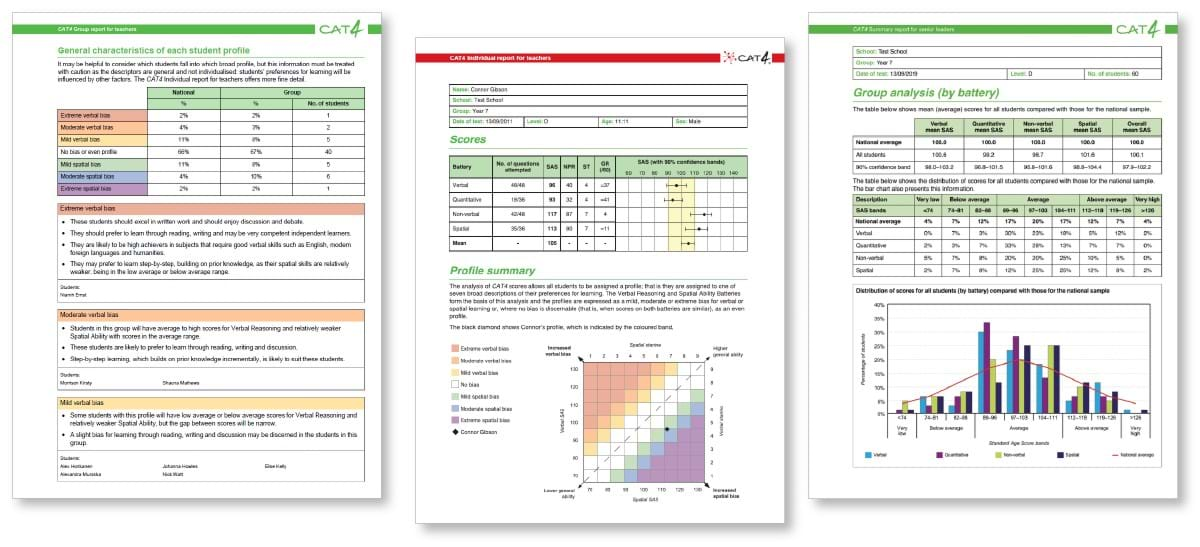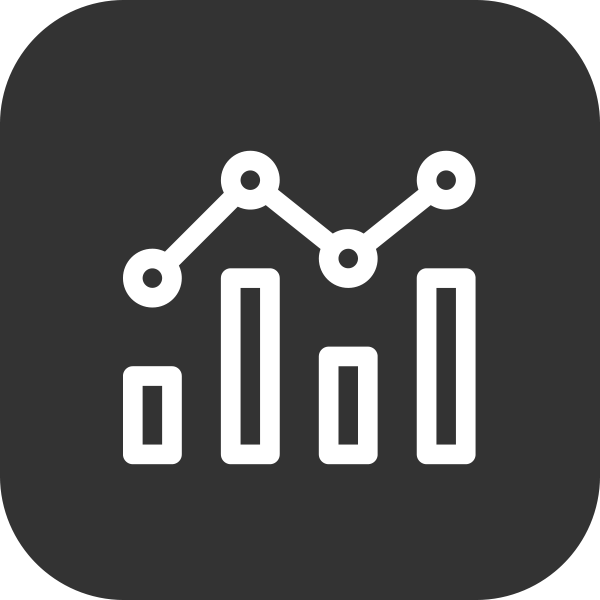Finn is an Assessment Insights Education Adviser at GL Assessment, who supports schools using his knowledge of how our assessments can be used to improve their learners’ outcomes. He has 16 years of teaching and senior leadership experience in primary, independent and international schools and is committed to bringing that perspective when talking to schools about assessments. Below he introduces our Cognitive Abilities Test (CAT4).
What is CAT4?
“It’s a standardised assessment that assesses a learner’s natural ability. Using content that is not related to a school curriculum, it measures the main areas of reasoning ability known to make a difference to learning. It provides a rounded view of the learner’s potential, highlighting strengths not always noticeable in the classroom and can be used to identify potential barriers to learning.
“It can be used in all sectors, and at different times of the year depending on needs, such as the beginning of secondary school for baselining and early GCSE indicators.”
What can schools discover about their learners?
“A huge amount! As well as providing a clear sense of a learner’s capabilities, it analyses their verbal, non-verbal, quantitative, and spatial abilities. While identifying learners with high (or low) verbal (language) and quantitative (number) abilities – usually the most obvious – it also analyses the ‘harder to spot’ and sometimes ‘hidden’ spatial ability (the ability to mentally manipulate objects in 3D) and non-verbal (problem solving) abilities.
“We sometimes refer to the uncovering of hidden potential as providing ‘lightbulb moments’ – a phrase we first heard from one of our schools. For example, I taught a learner whose attainment was ‘average’, with him consistently working at age-expected levels. However, when he took CAT4 his spatial ability score was 141, as high as you can get. I was amazed as I just hadn’t noticed this strength before.
“With this new insight, we started to spot clues showing his incredible ability at visualising and working in 3D. He could do a Rubik’s Cube in seconds. In art, his technical drawing was exceptional. When I met his parents, I was able to explain this special strength and how it can be developed to provide a bright future. CAT4 was the catalyst that helped us to help him realise his skills. Perhaps he will go on to become a world-famous engineer or architect one day?
“As the quantitative, non-verbal and spatial batteries of CAT4 don’t rely on language capability, they shed light on the hidden abilities of those with reading difficulties who may be easily overlooked. This is also true for EAL learners or those with specific learning needs.”
How can it help teachers adapt their interactions with learners?
“We compiled our CAT4 Strategies for Learning guide specifically to answer this question. It’s full of practical ideas for supporting learners in the classroom, both to build on their strengths and support their areas for development. Dip into this and pull out strategies to adjust teaching to help ensure all learners can fully engage with the lesson content.
“We also provide free online CAT4 training resources and one to-one data consultations with our Assessment Insights team, made up of former teachers and senior leaders. This gives an additional layer of insight, helping schools extract the most useful information from CAT4 to inform and adapt their teaching approaches. The message we are keen for schools to know is that when you choose to use CAT4, you’re never alone!”
Can CAT4 data be compared with attainment data?
“Definitely, and this is often where those lightbulb moments come from. Our combination report combines CAT4 data with the Progress Test in English (PTE), Progress Test in Maths (PTM) or the New Group Reading Test (NGRT). It’s a process called triangulation, and produces all-round (sometimes startling) learner profiles. The report identifies learners currently working higher (or much higher), at, or lower (or even much lower) than expected standards when comparing underlying abilities from CAT4 with attainment scores from the PT Series or NGRT. You can also see this in the individual student view on the GL Data Dashboard.
“CAT4’s contribution to triangulation is one of the biggest reasons for using it, specifically because it isn’t measuring attainment, and is non-curricular. When speaking to schools, I always explain that combination reports are hugely important, because they identify learners not working to their full potential.
“When I was teaching in independent schools, many learners were high-achievers, but only by using CAT4 could we see if they really were working to their capabilities or had even more to achieve. Without CAT4 we just wouldn’t know, so it can be a real eye-opener at this end of the scale. For example, a learner with a PTM score of 112 is above average, but if they scored 138 in the quantitative battery of CAT4, this puts them in the top 1% of learners nationally and shows they have MUCH more to give if stretched.
“In two 15-minute videos, you can find out more about our combination reports, and how data triangulation works.”
How can CAT4 help schools analyse the potential of their learners?
“Because of its non-curriculum content, CAT4 isn’t skewed by a reliance on the more traditional measures of verbal and written skills, which may overlook gifted spatial thinkers. This way you get a more accurate idea of a learner’s true capability, sometimes with wonderful and surprising results.
“A colleague who is a former SENCo often speaks about the value of CAT4 for supporting the identification of potential barriers to learning too. She used it to build a picture of each learner’s strengths and challenges and says it helped her to spot those with an ‘uneven’ profile (where scores are discrepant across each of the four areas of reasoning) that may indicate specific difficulties.
“Since CAT4 is standardised on thousands of learners, you can also compare your current learner profiles with learners of a similar profile who have gone on to do GCSEs or A levels, to understand your learners’ potential to succeed.
“SATs indicators are also available for primary age learners, as well as retrospective KS2 indicators at Year 7 level. The powerful thing to realise about standardised data is that it’s not based on algorithms or calculations, but real data from real learners who sat CAT4 and went on to do national exams.”
What do the reports look like?
“With so much information available it’s important that it’s easy to access, therefore we’ve prioritised the layout and design to spot patterns quickly.
“A wide range of reports are available, including individual and group reports for teachers, summary reports for senior leaders and even reports for parents and the students themselves.


“On the GL Data Dashboard, you can also see data from all assessments by school, class or individual students brought together on one screen. As new assessments are taken, the dashboard updates automatically. When we talk to schools using the dashboard, one phrase keeps coming up, and that’s ‘game-changer’.
“As an assessment lead in school I spent hours compiling data, so I feel really excited about the benefits of the dashboard and how much time it can save teachers.
“Watch our 15-minute video walkthrough of the GL Data Dashboard. You can also read Crispin Chatterton’s article, 'How you’re helping us shape your assessment journey', explaining how the dashboard is evolving based on teacher feedback.”
In what ways can CAT4 be used to analyse value-added?
“Our partnership with FFT Education (Fischer Family Trust) allows maintained schools to upload CAT4 scores into FFT Aspire, which feeds into GCSE estimates for all learners. This helps teachers set targets for learners in every subject, monitor progress and estimate likely GCSE outcomes. You can also access summaries and benchmark estimates of gender and prior attainment groups.
“For independent and international schools, FFT offers a Value-Added Service comparing a cohort’s CAT4 profiles with their GCSE or A level exam results to show what value a school has added. This is illustrated in a series of easy-to-read dashboards.
“To evaluate value-added prior to GCSEs, our combination reports allow schools to use the learners’ abilities, identified by CAT4, as their baseline starting point when analysing their current attainment levels in maths, English and reading.
“I’m often asked how schools can monitor value-added prior to national exams, and combination reports are the key here. With these you can achieve a reliable baseline for each learner, and as they are re-tested the comparisons in their scores make clear where teaching strategies have had an impact.
“I also get asked about the benefits of learners joining the school later in the year doing CAT4 too, and definitely recommend it so you immediately have a baseline for them as well.”


